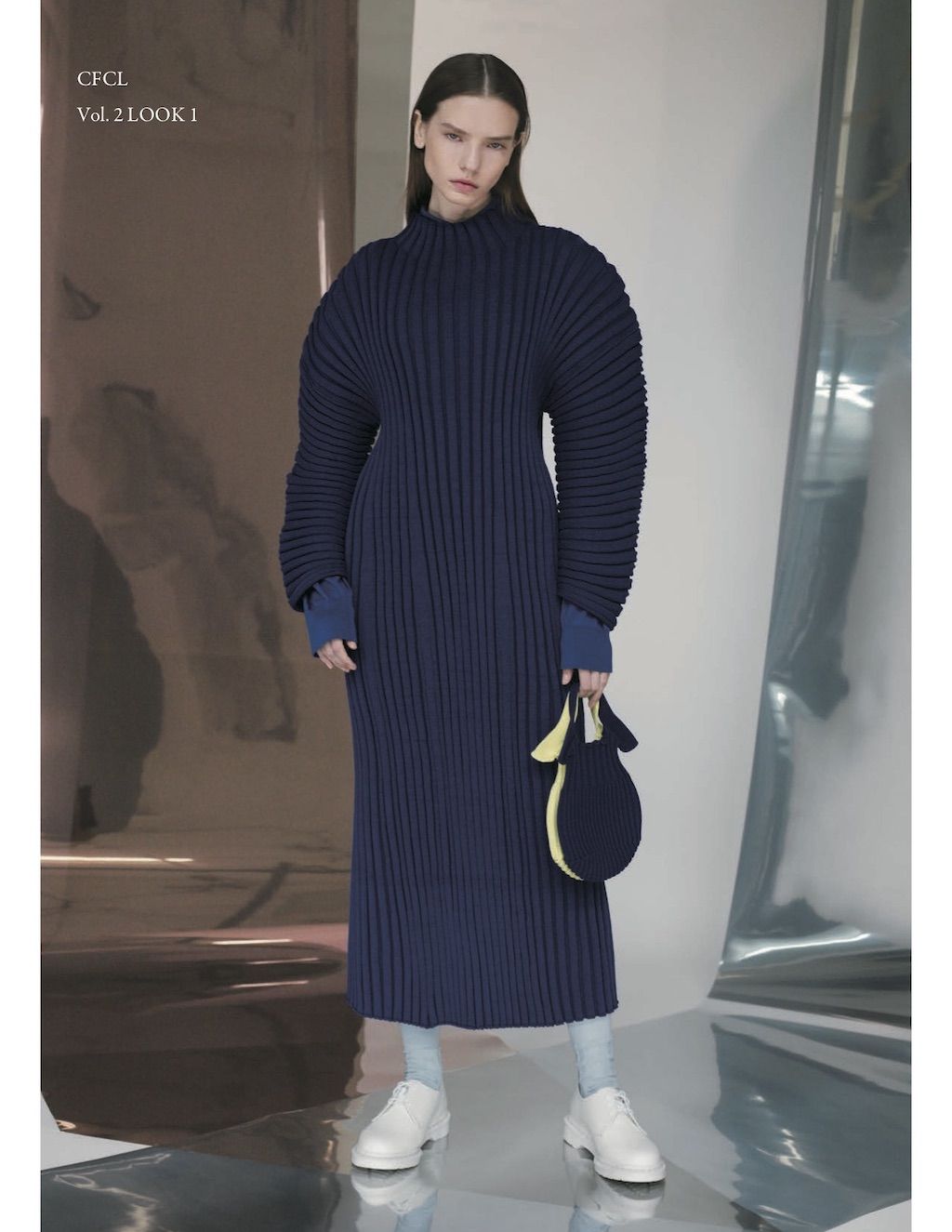

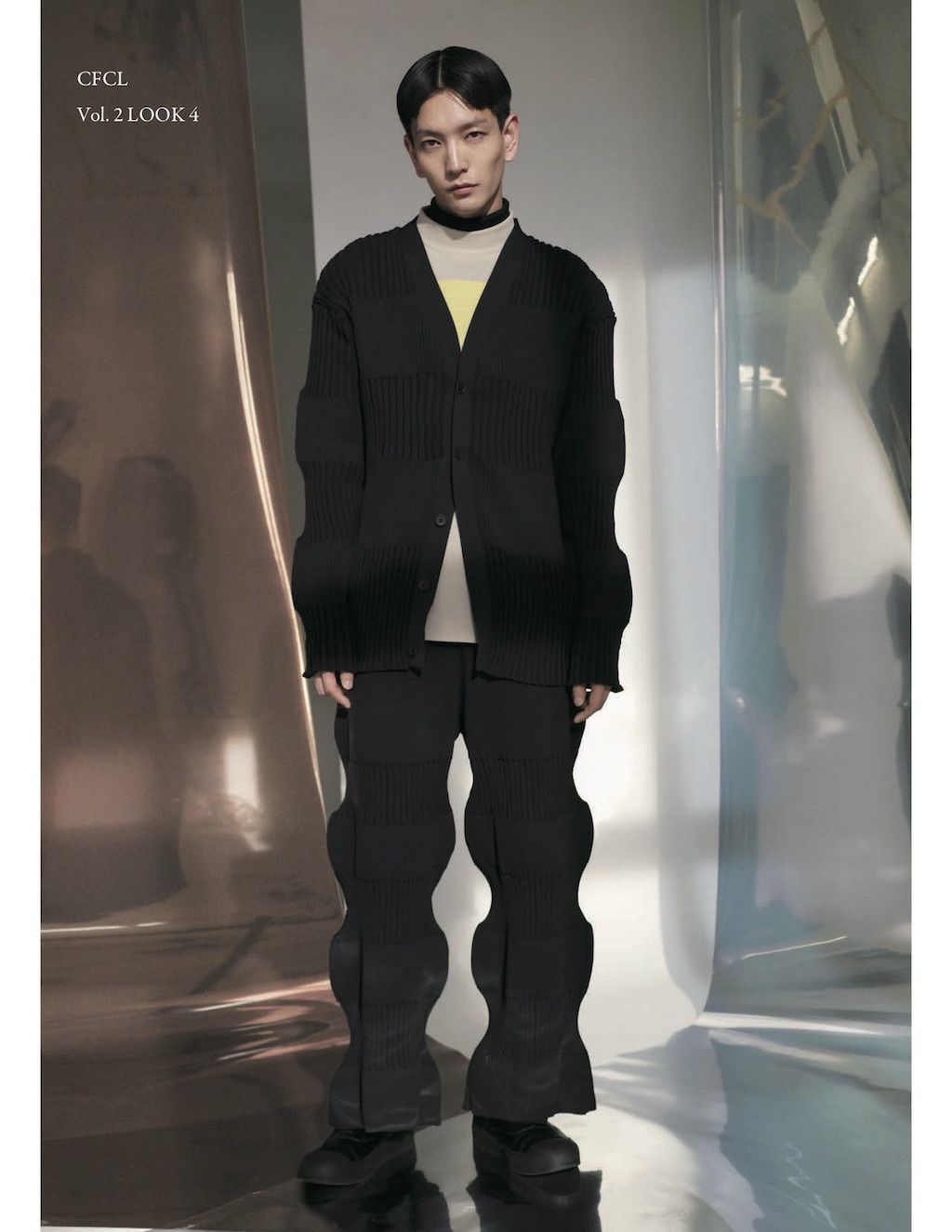
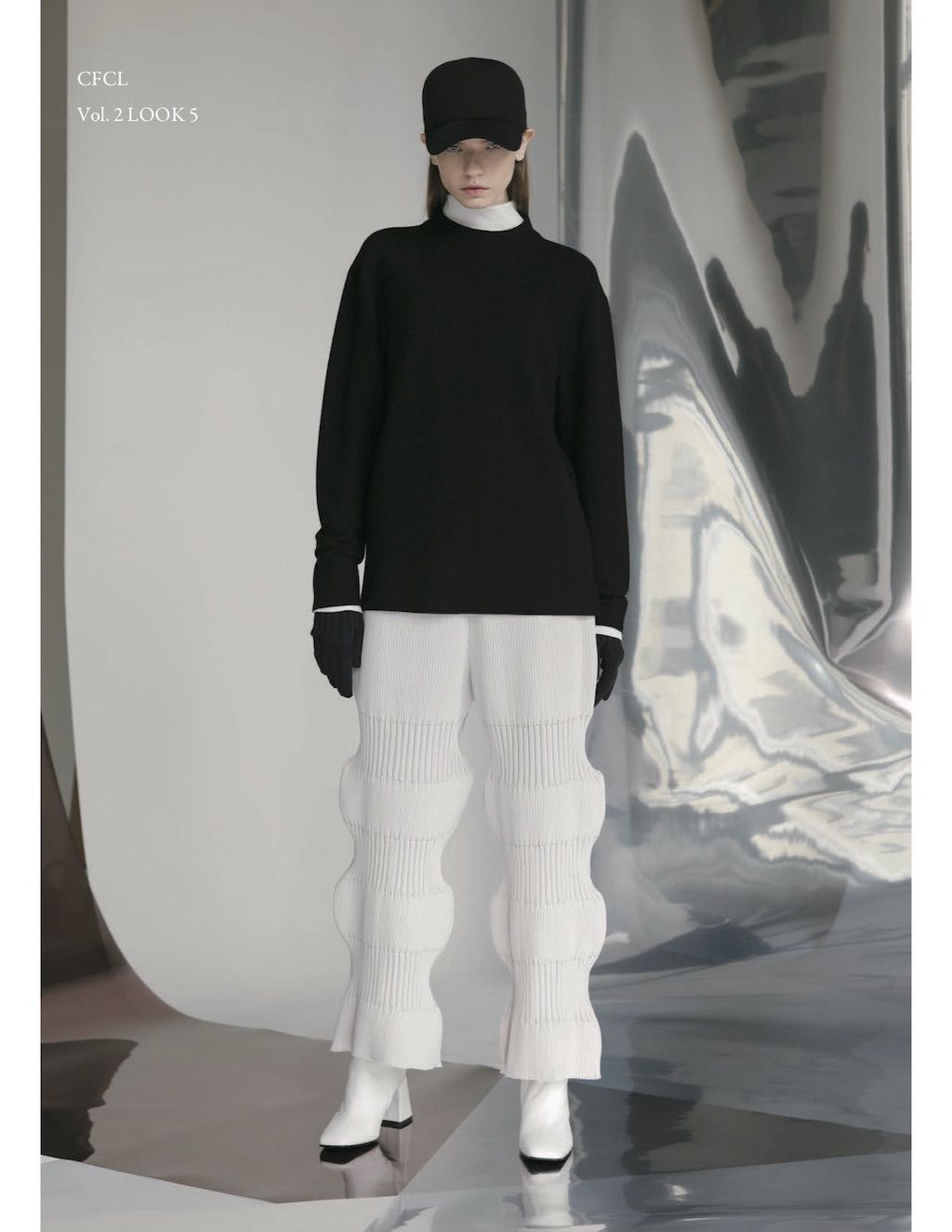

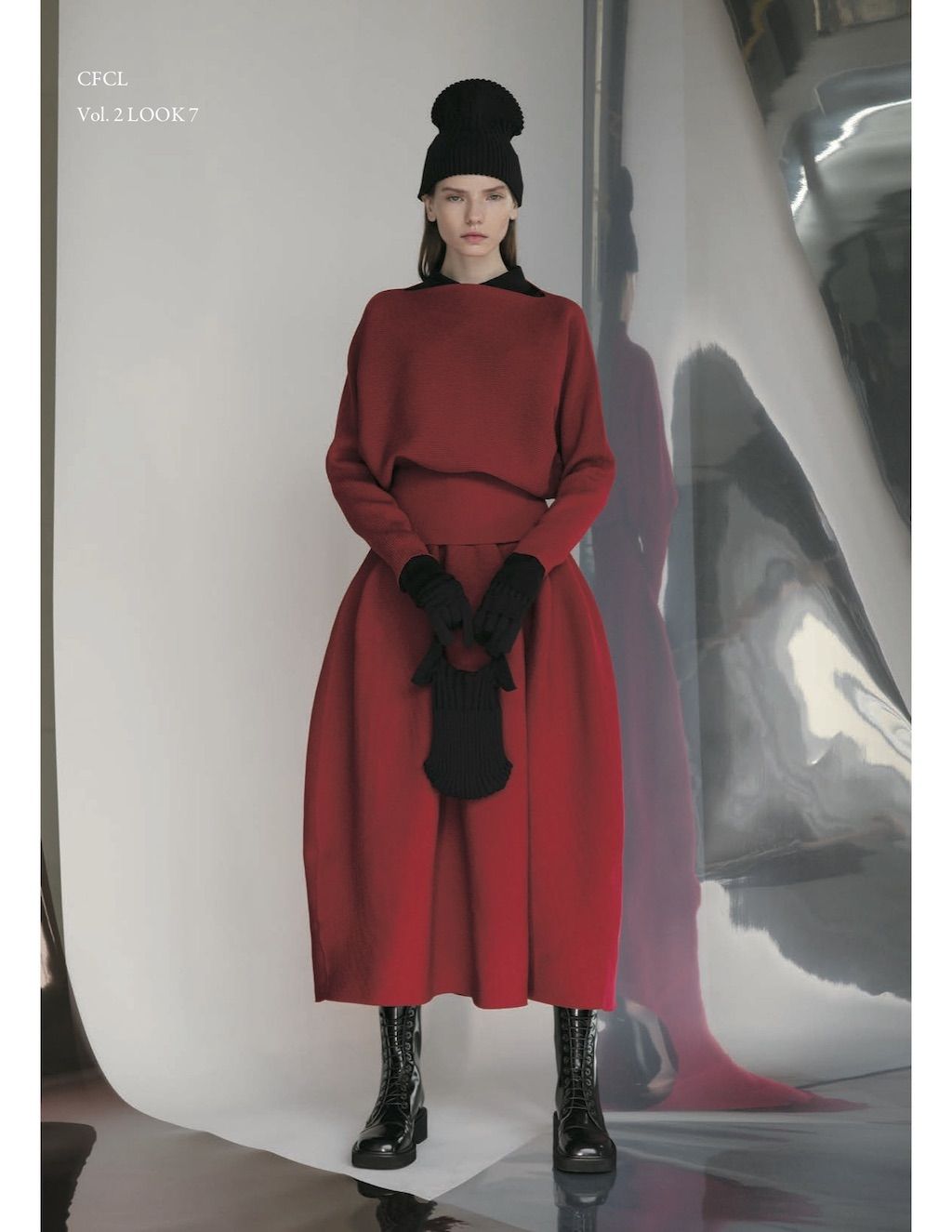
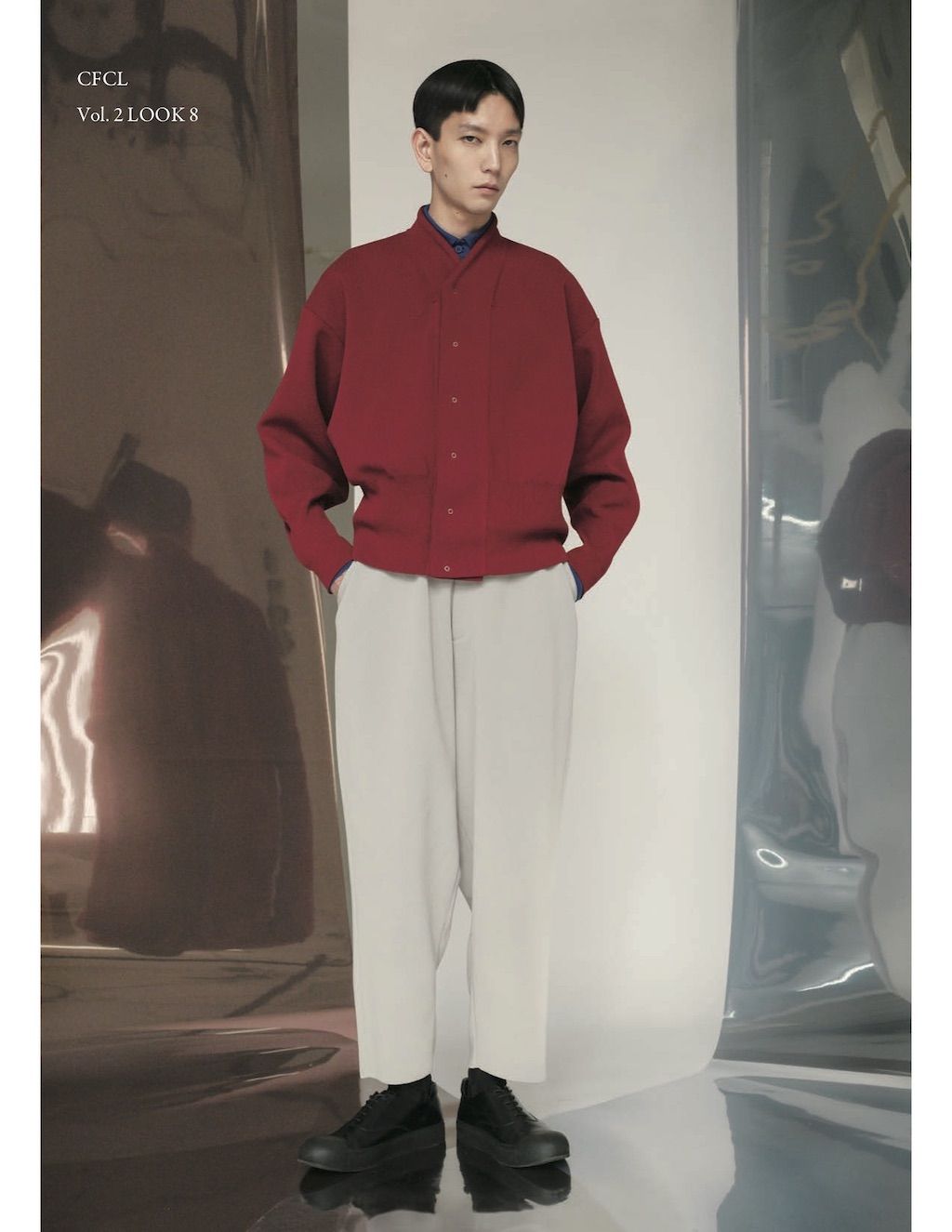
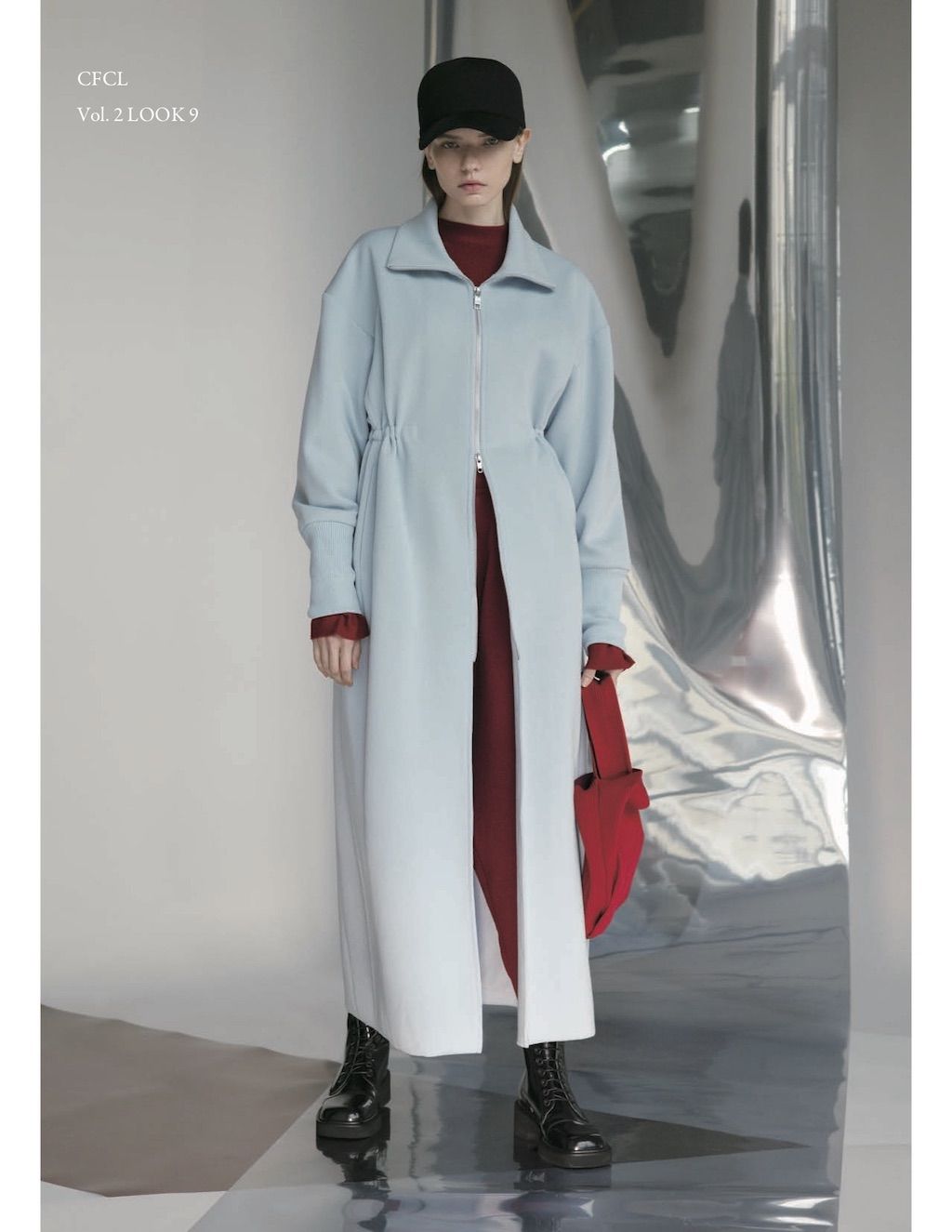
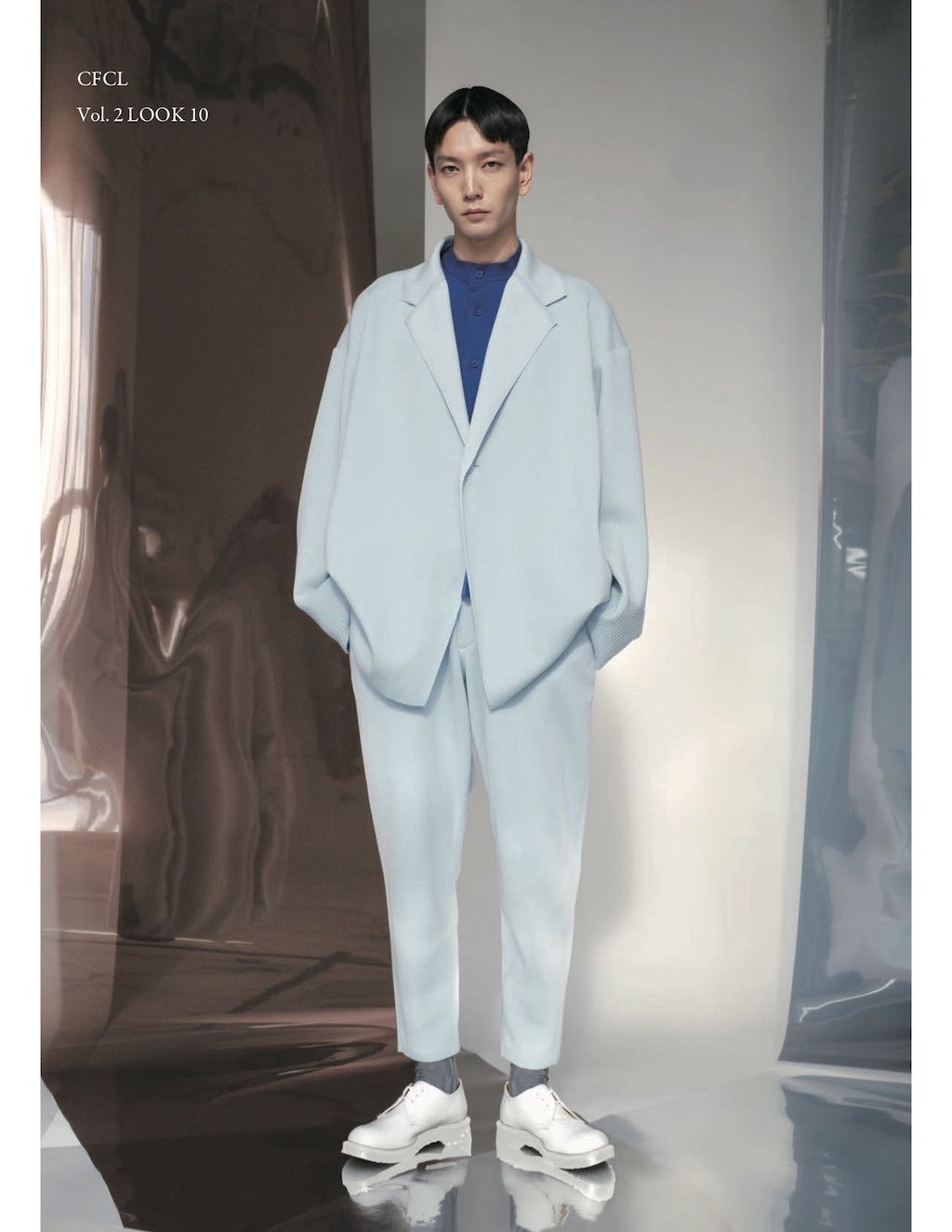
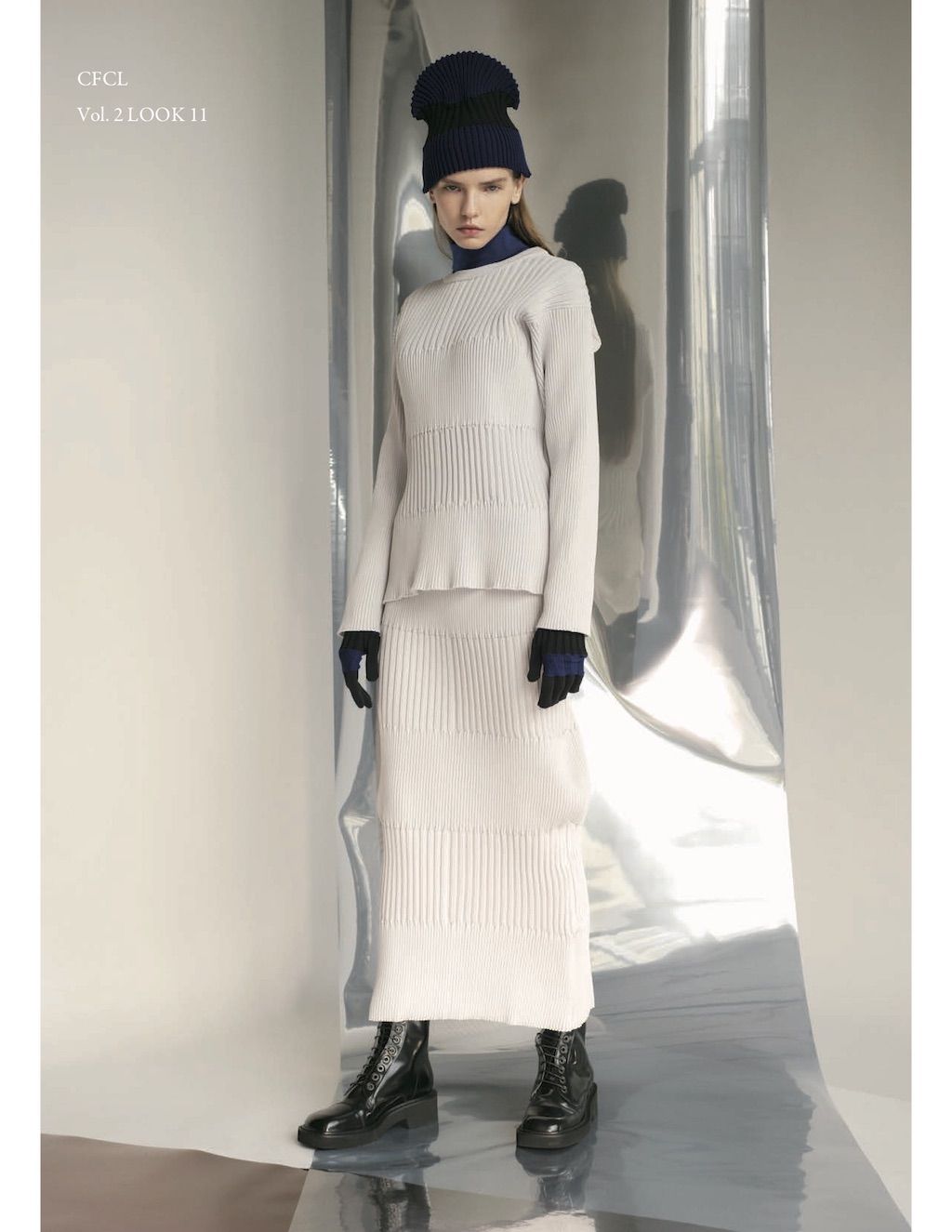
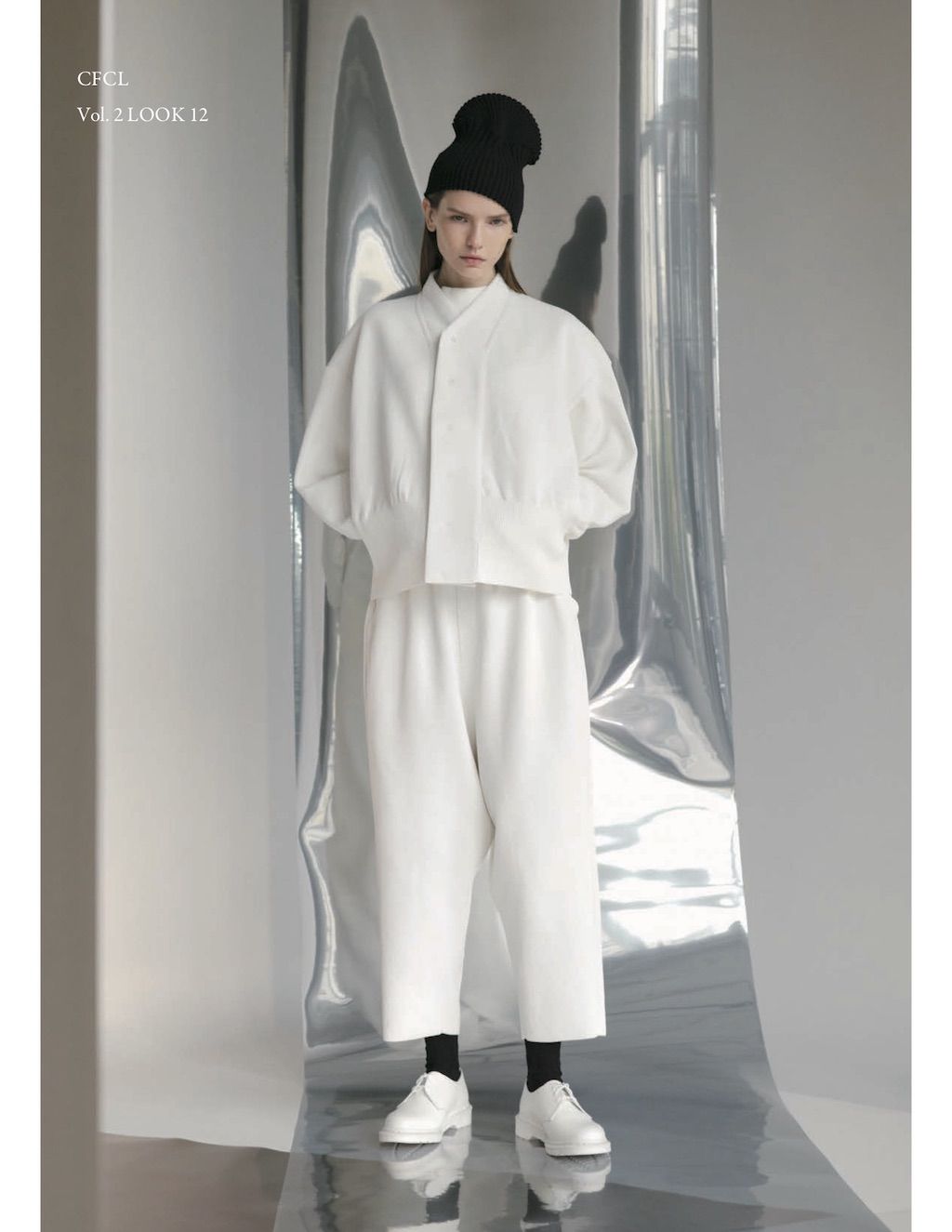
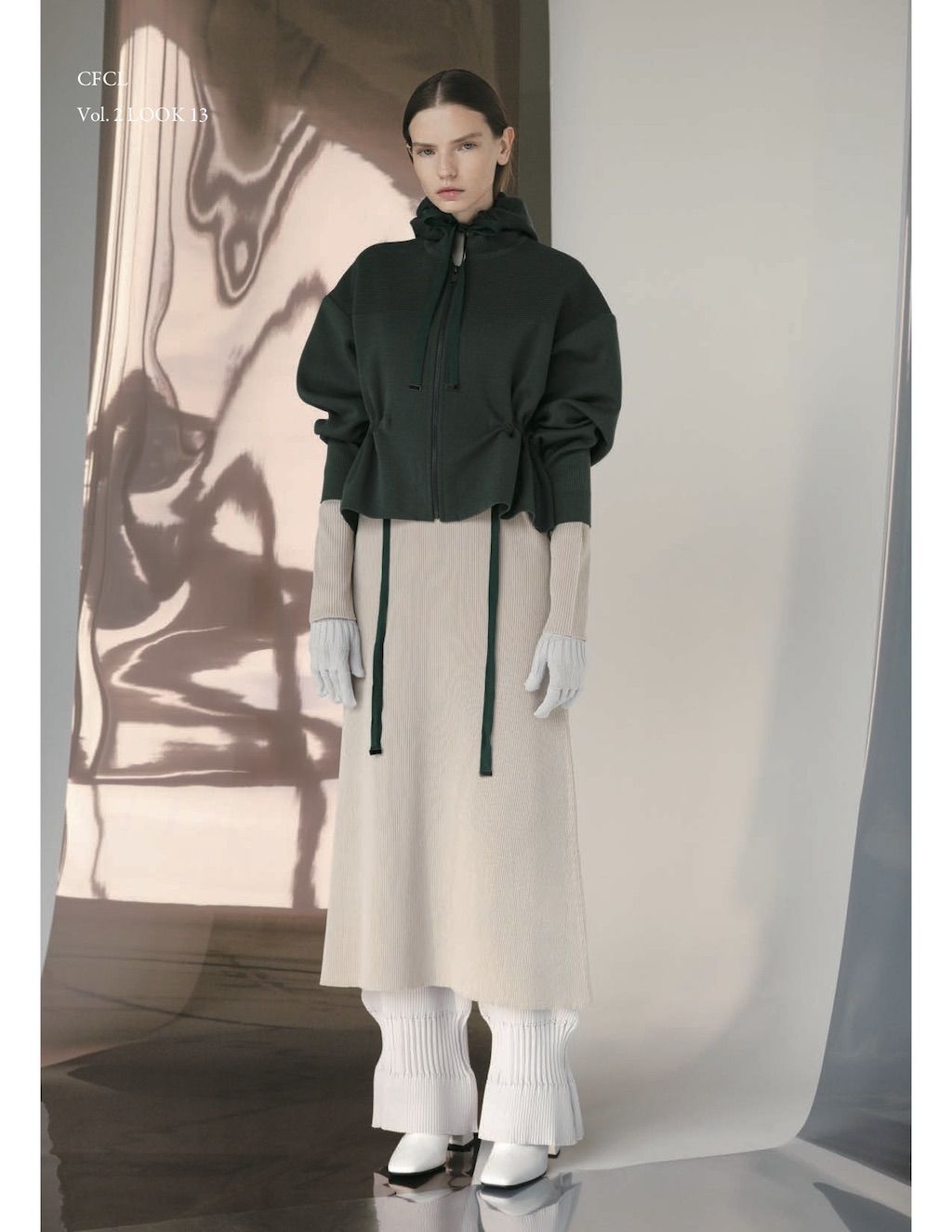
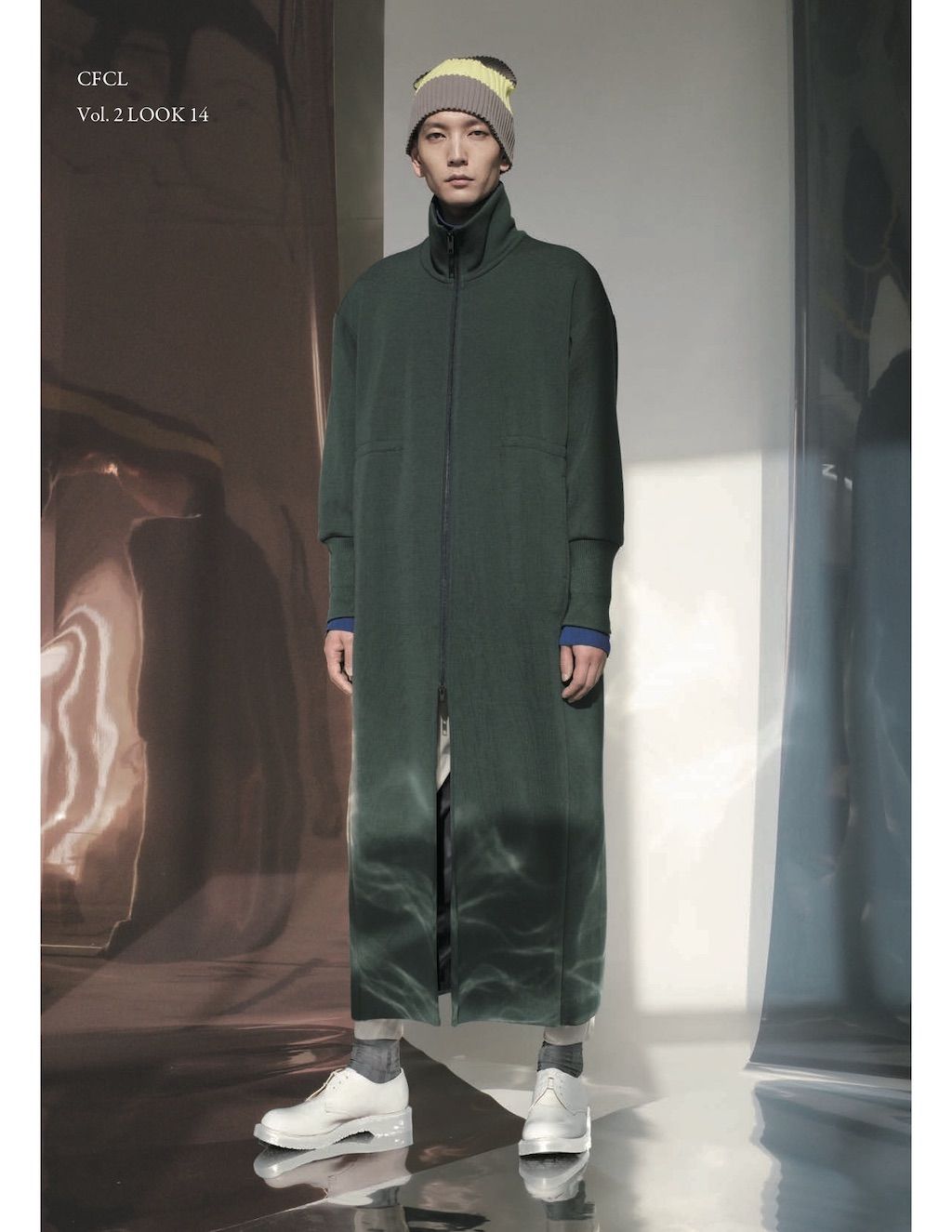
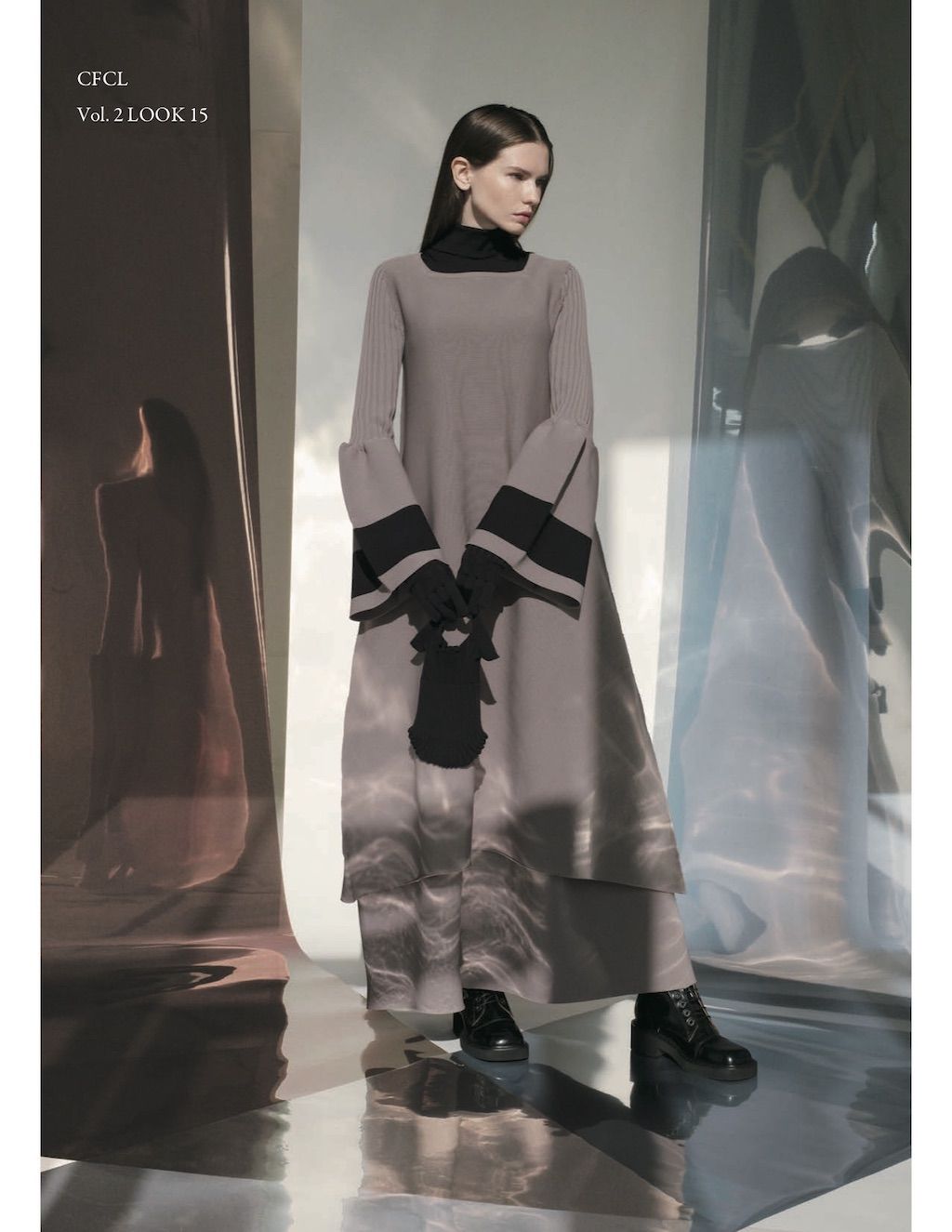
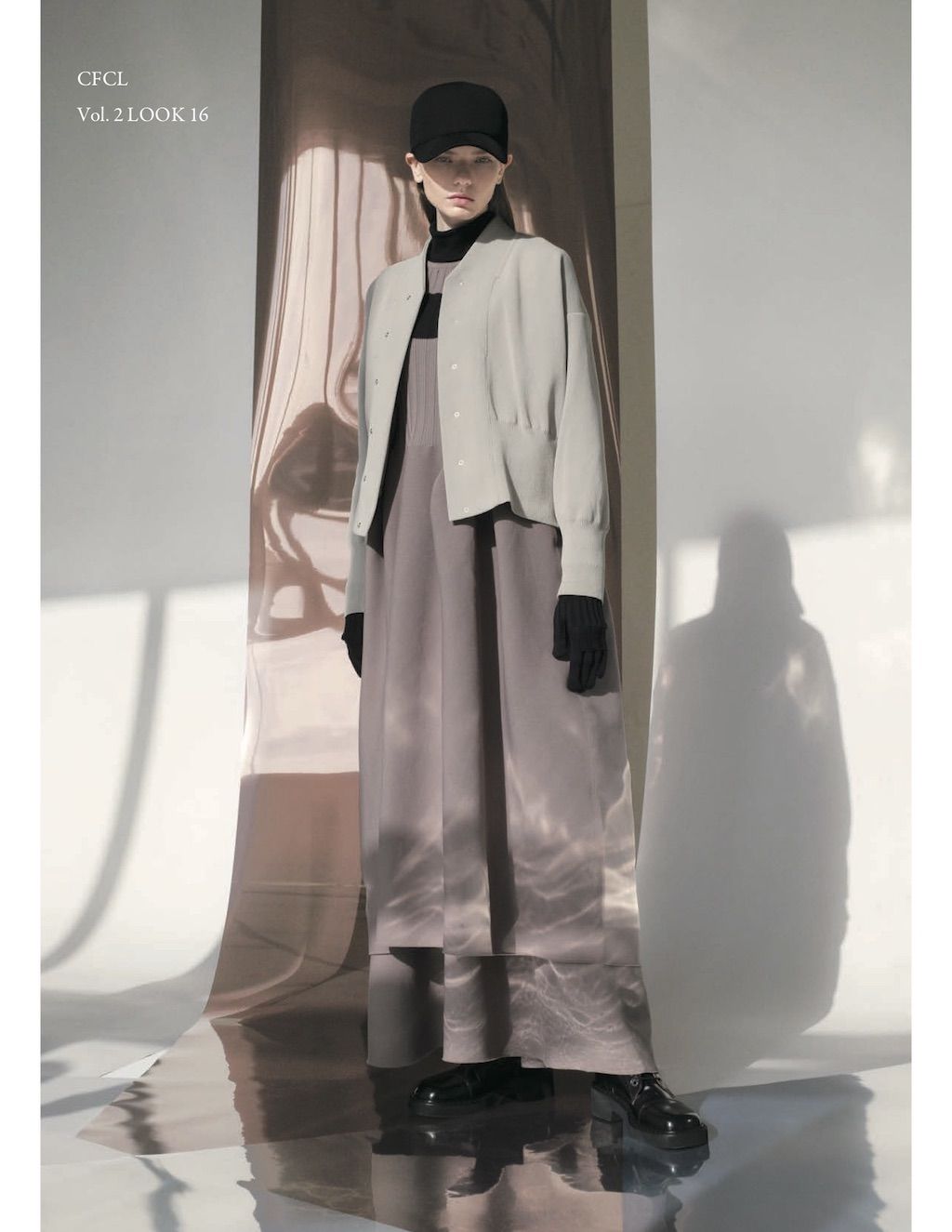
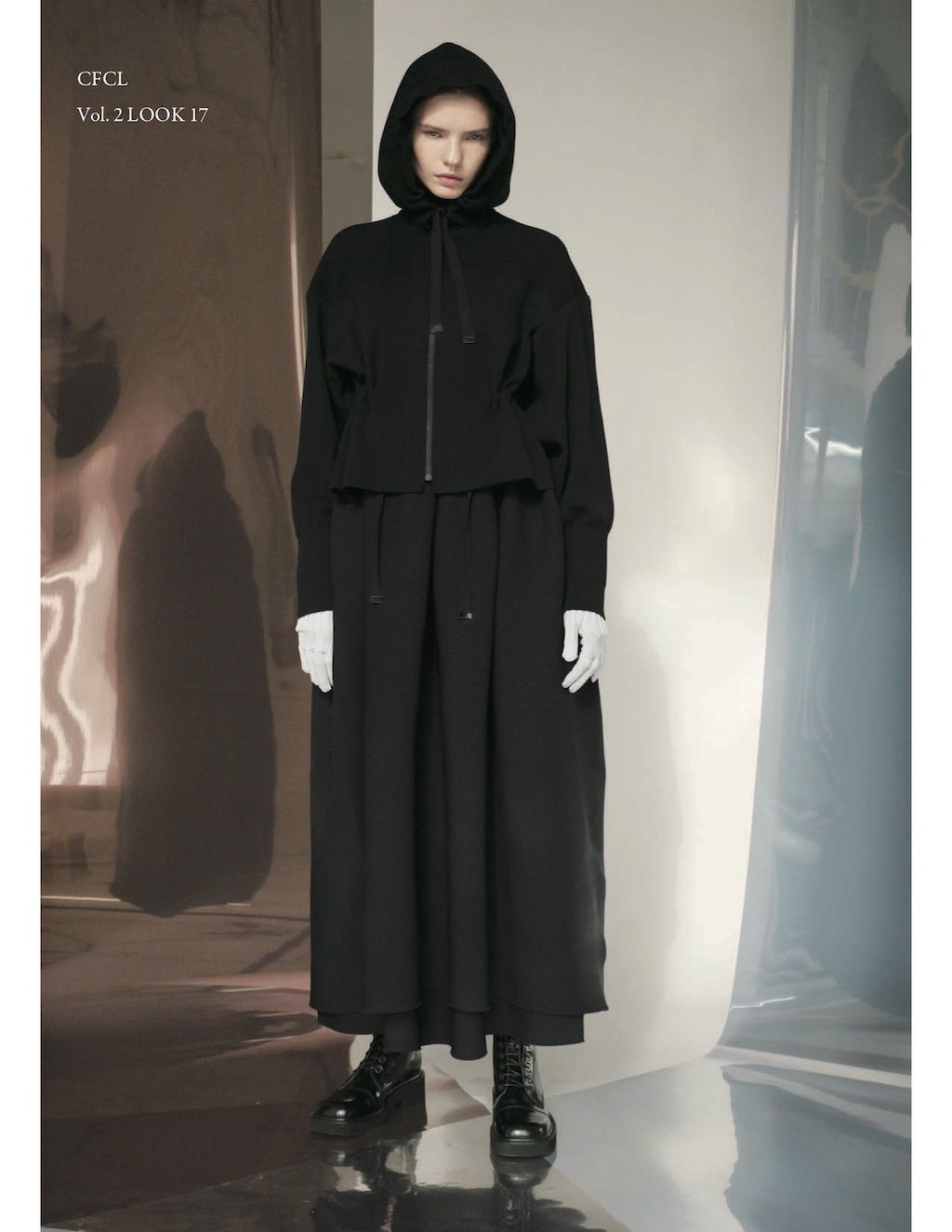
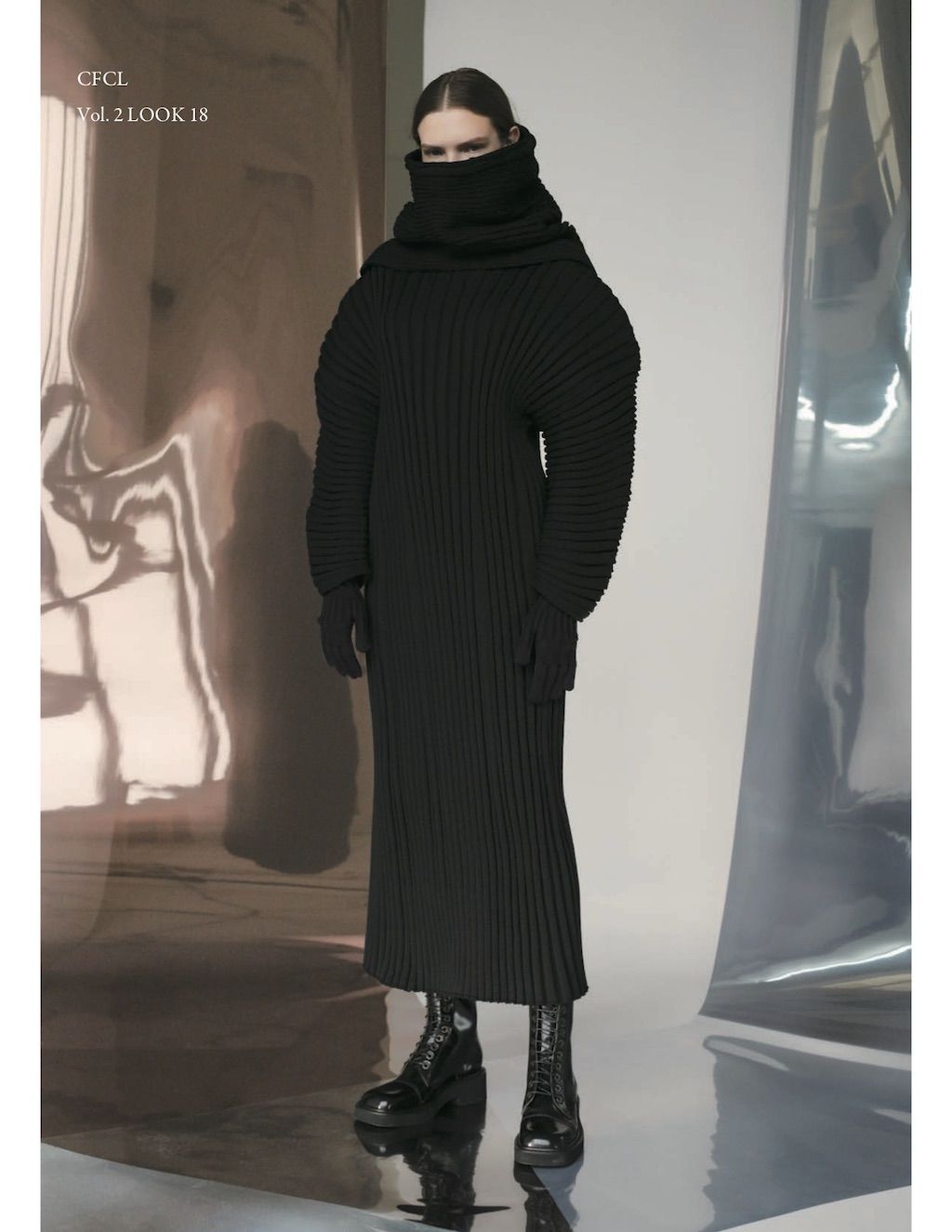
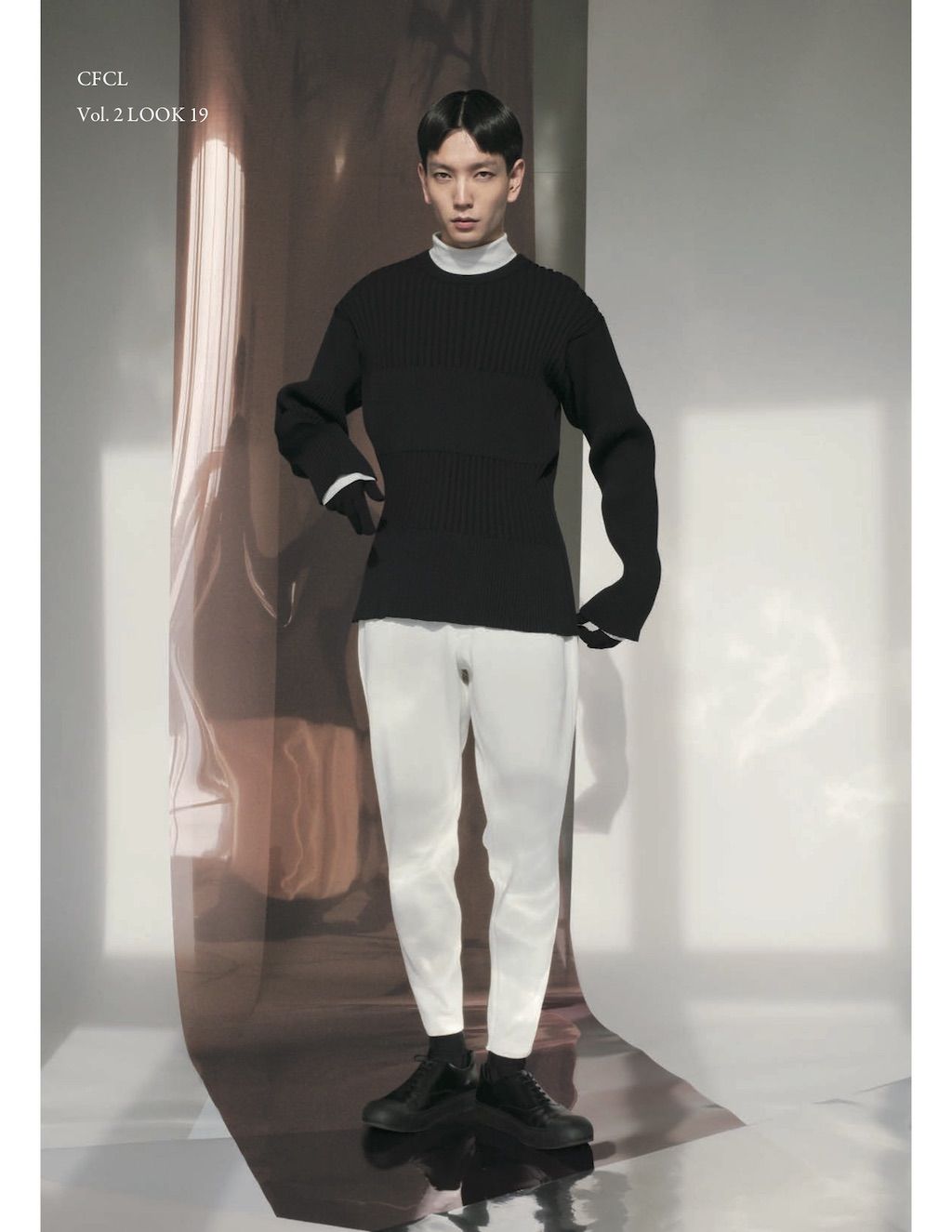
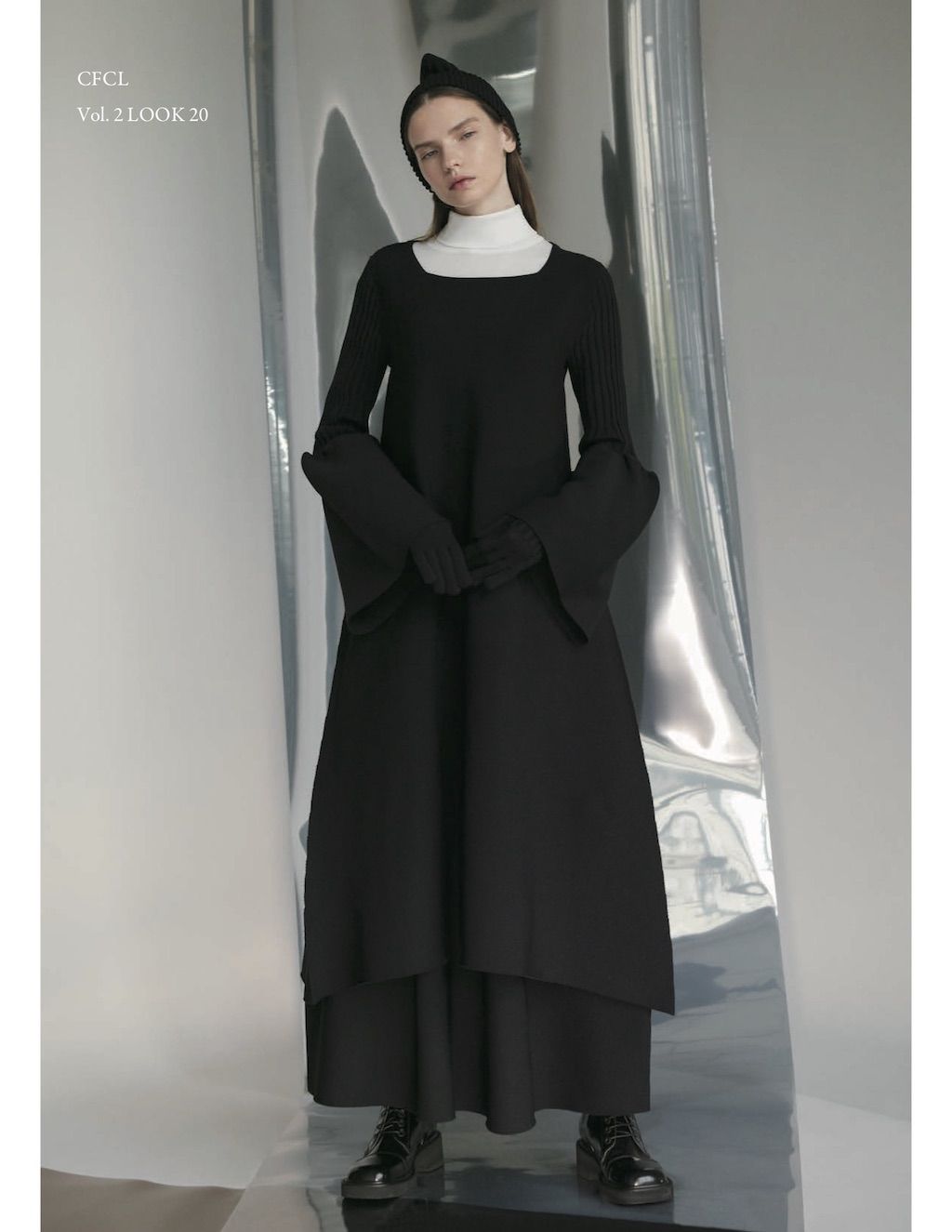
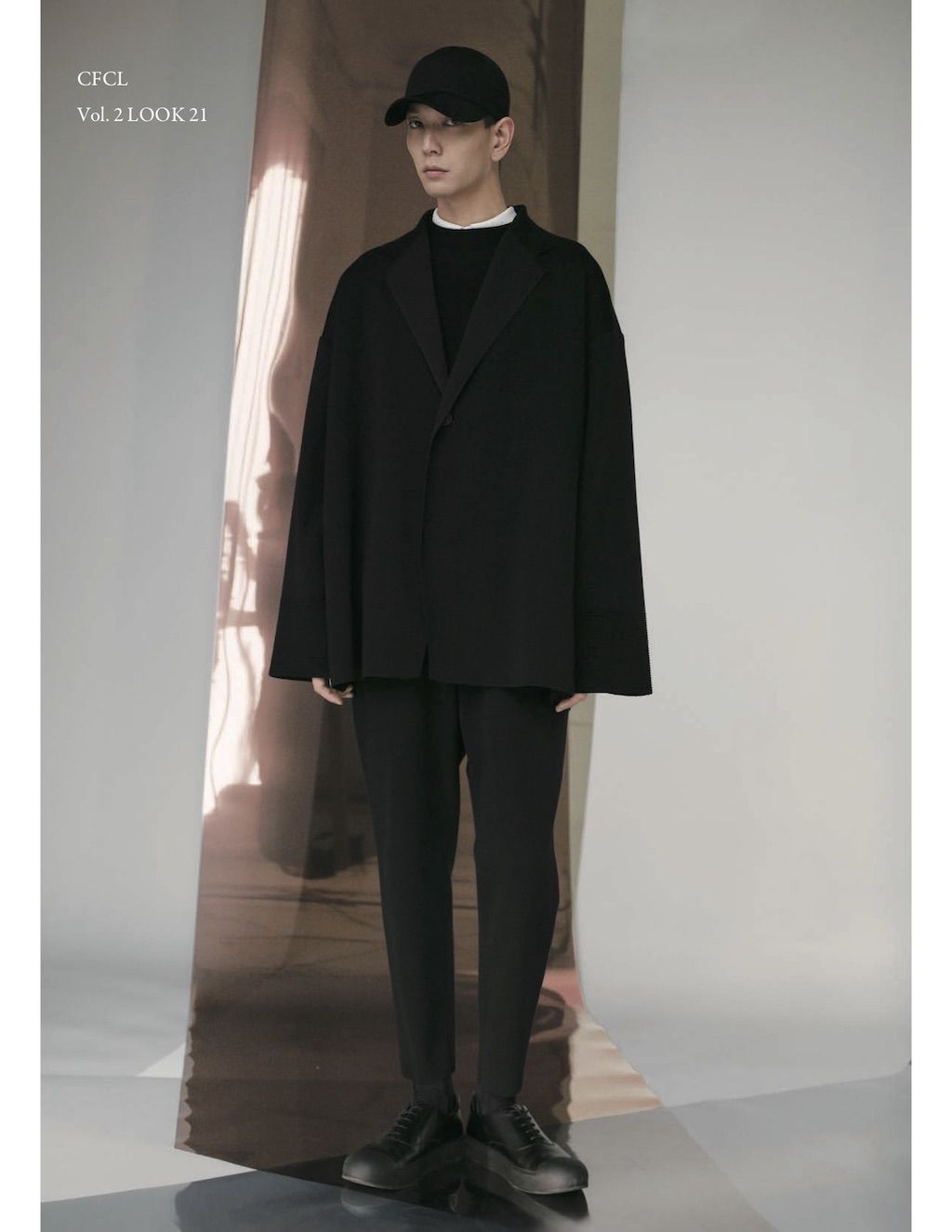
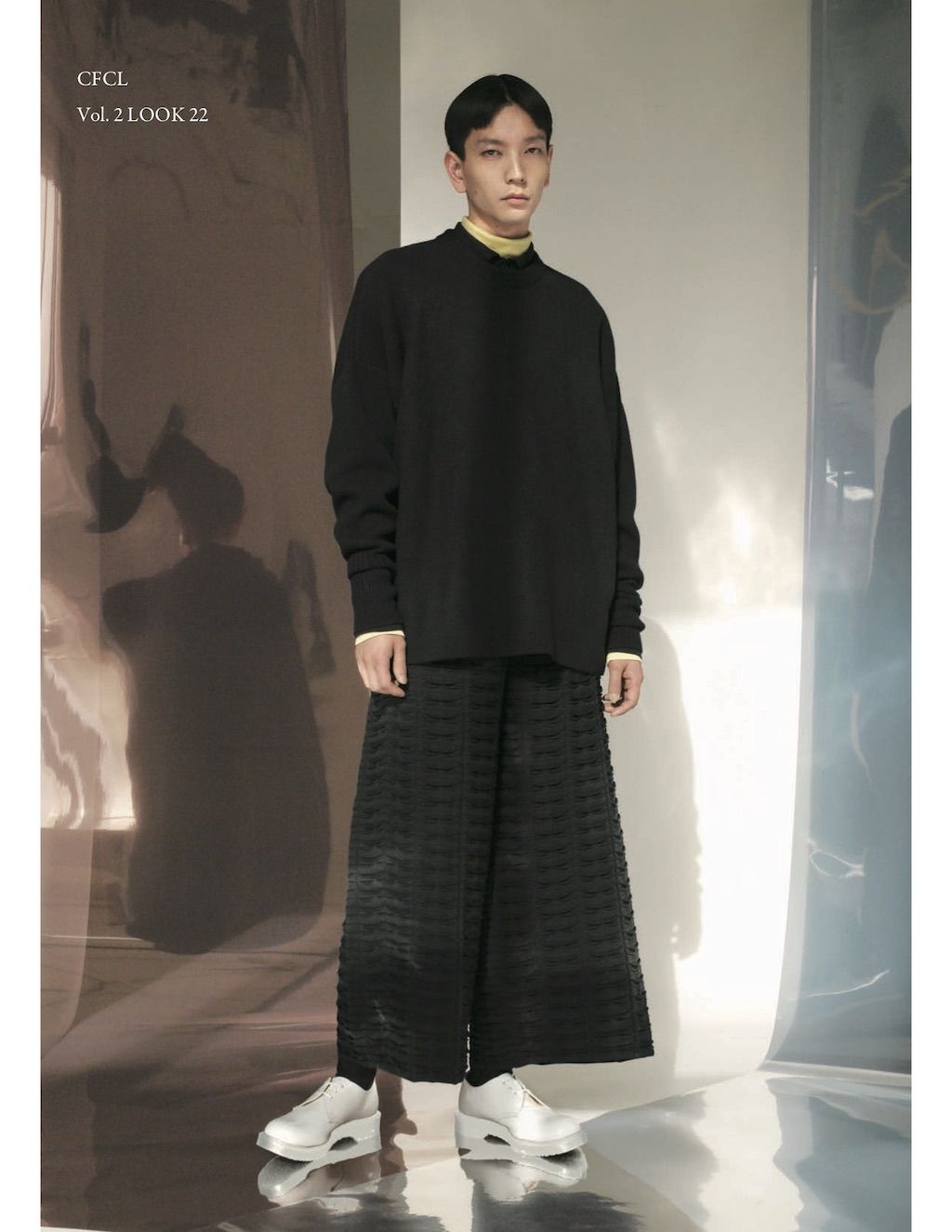
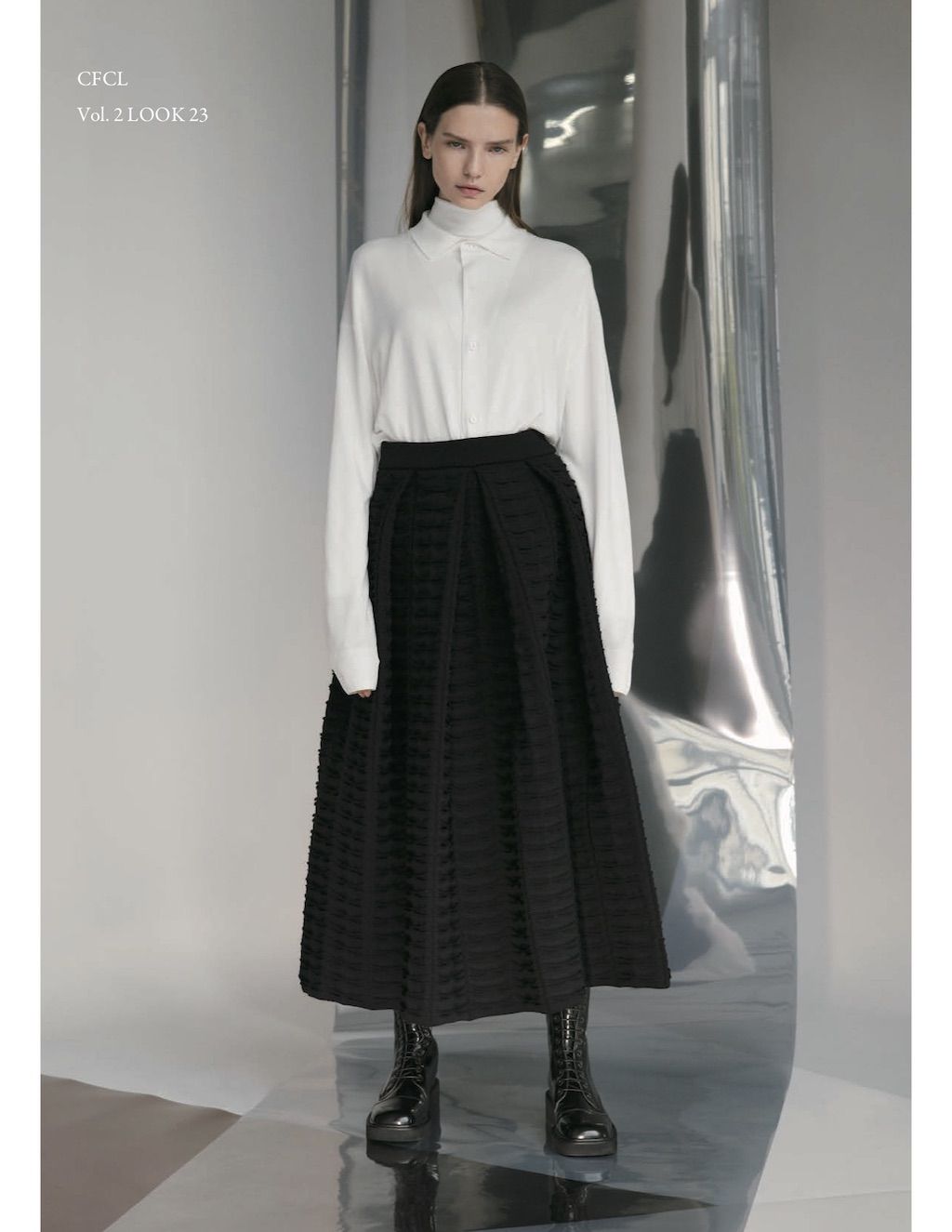
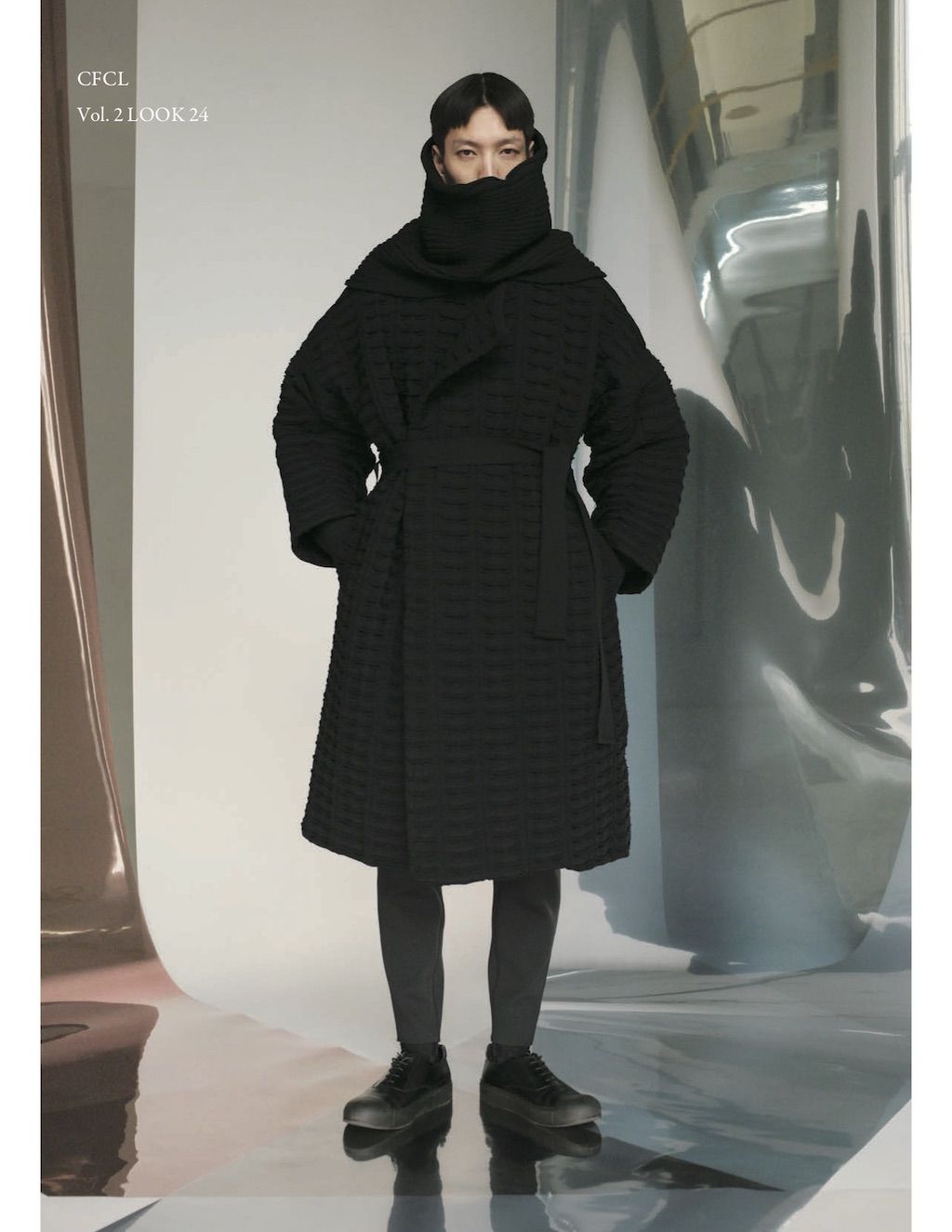
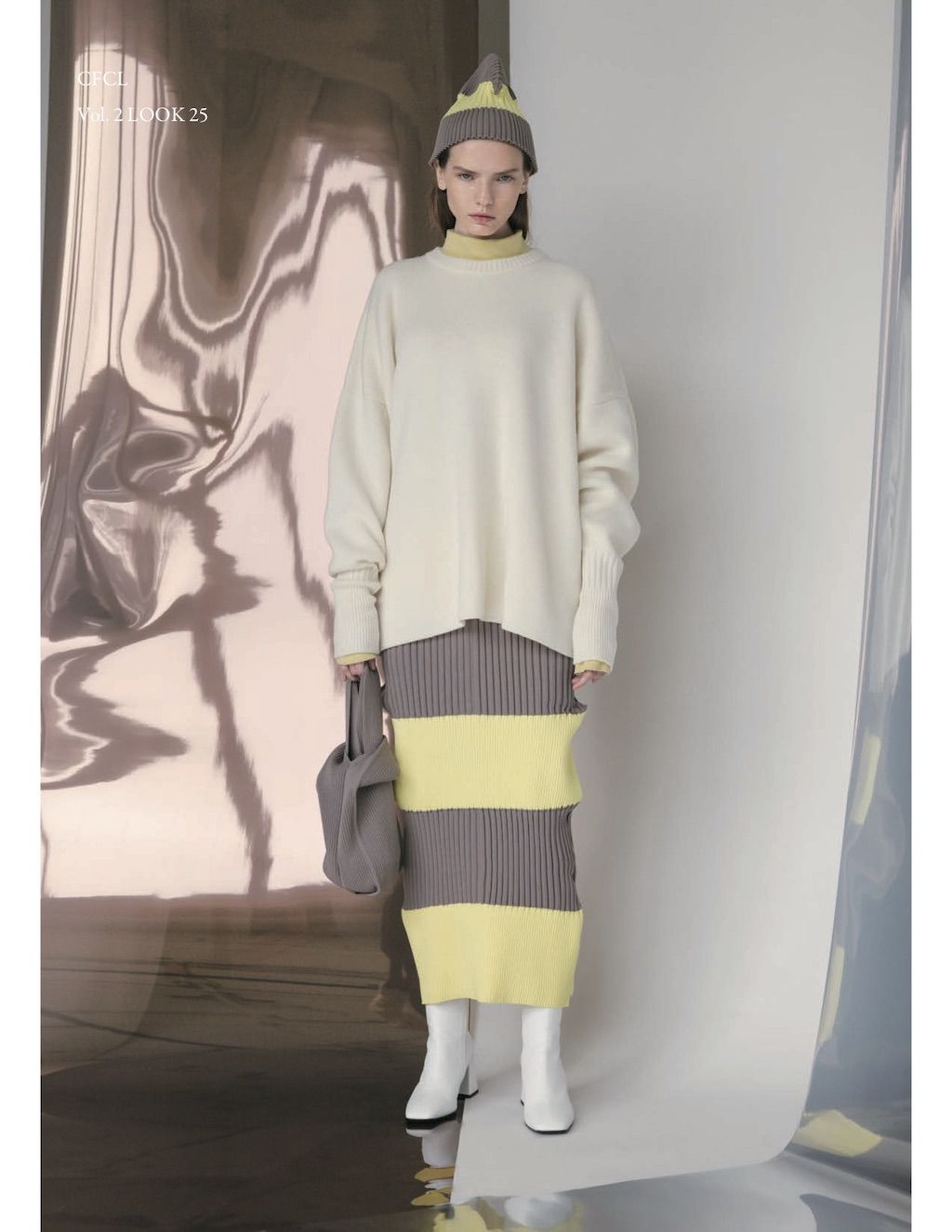

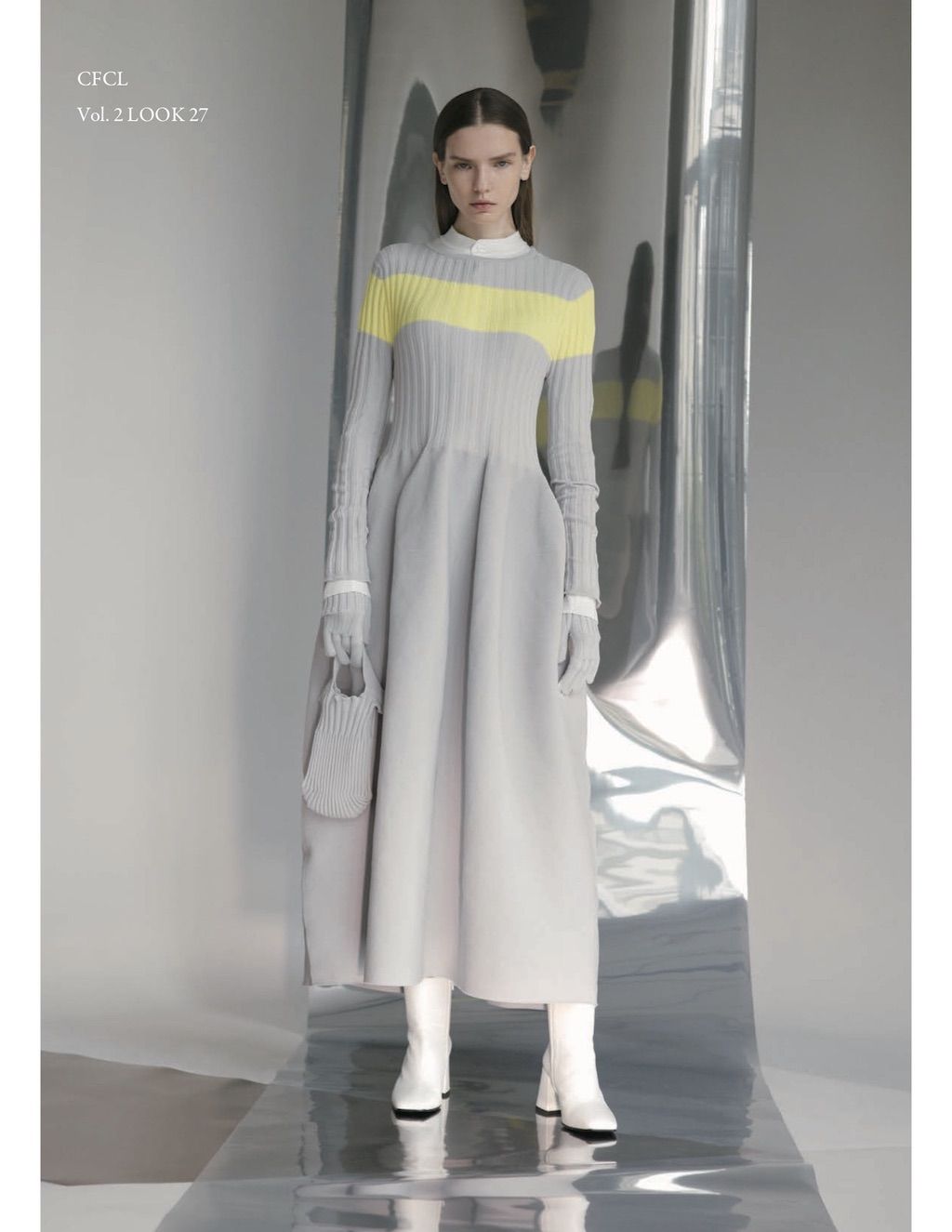
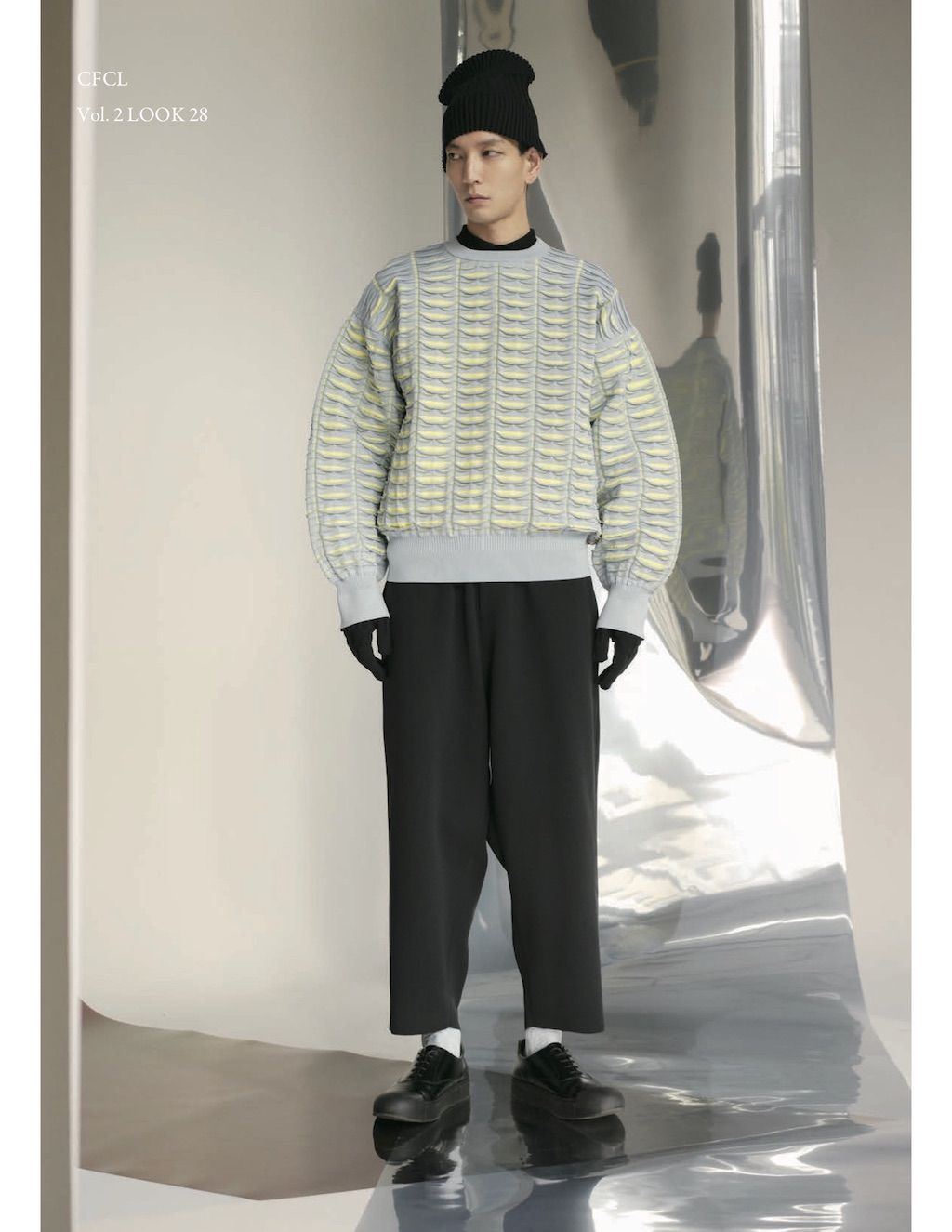
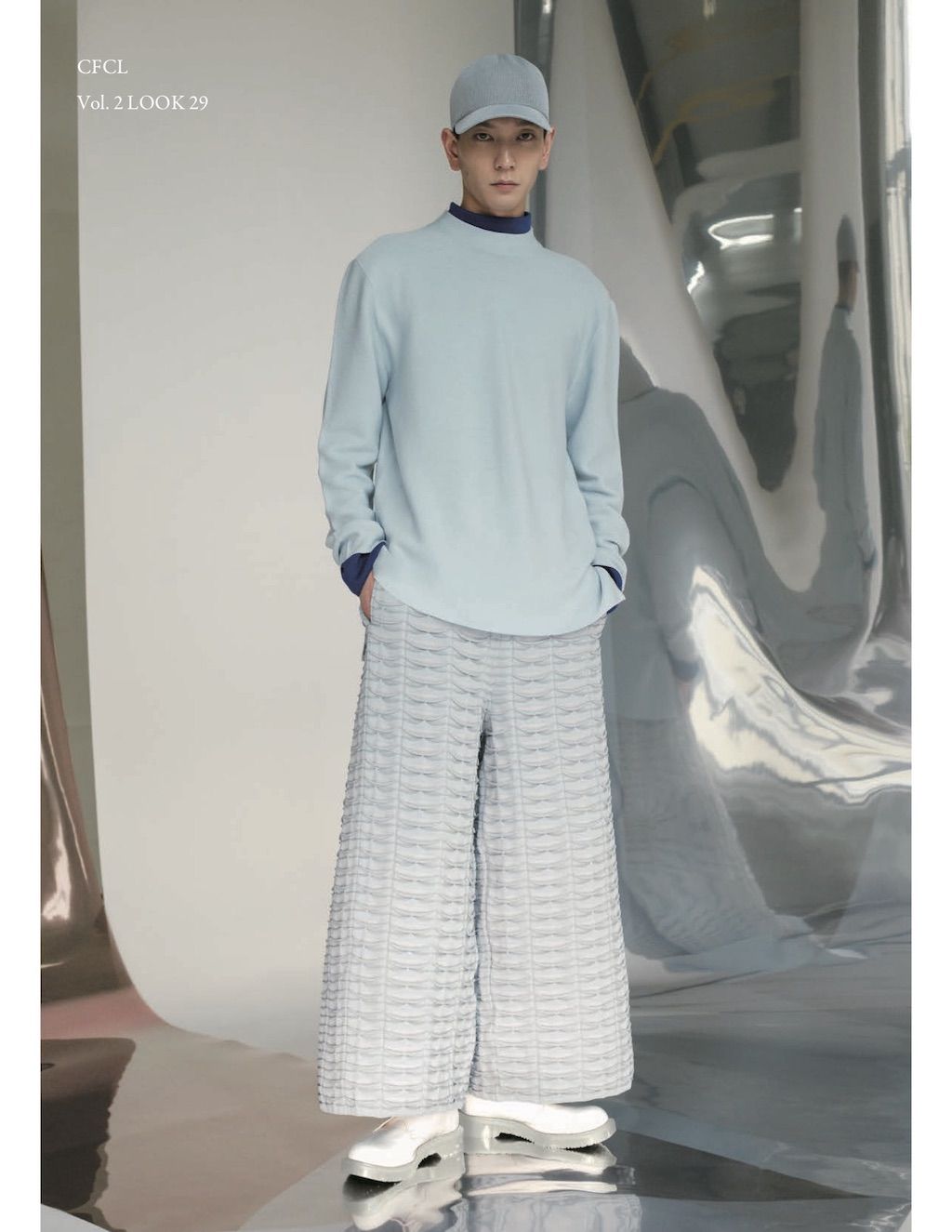

© YUSUKE TAKAHASHI
Yusuke Takahashi
AUGUST 14, 2021 → WORDS RONALD KAHIHIKOLO
CFCL — Clothing For Contemporary Life — personifies designer Yusuke Takahashi’s aspiration to create sustainable unisex garments suitable for all occasions. Takahashi launched CFCL back in 2020, shortly after ending his seven-year-long tenure as director of Issey Miyake Men.
The core elements of the brand are built on sustainability and ethically made clothes that promote a minimal and modest look. With a timeless approach and ethos, CFCL implements cutting edge technology to create its astonishing garments. This season's garments consist primarily of 3D, computer-developed knitwear using certified, sustainable polyester yarns and state of the art technology. CFCL assesses knitwear as a progressive laboratory for innovative fashion-making that matches the needs of contemporary life with products that are sophisticated as they are easy to maintain.
CFCL's debut collection launched with 40 retailers worldwide: ISETAN, SKP, United Arrows, Galeries Lafayette, Tomorrowland as well as SSENSE.com and its own website www.CFCL.jp. This AW21 they will be launching with Selfridges.
What are the core elements of your brand? Why are these elements important for you to explore?
The core elements of the brand stem from our name CFCL which means to make “clothes for contemporary life.” Since the modern world is constantly evolving, we need to keep thinking and redefining what contemporary life is all about. At the moment, there are three core elements listed below that the brand stands for and if we find any of them missing from our garments, we will not allow the CFCL brand tag to be placed on it.
The core elements are:
Sophistication → We place importance on the integrity of our products which are suitable for an array of occasions in the city.
Consciousness → Not only do we use recycled fibers in all of our products, but we also place the importance on ensuring transparency by disclosing the percentage of certified recycled fibers used in mass production and the results of LCA calculations for all of our products (currently only some, but in the future all).
Comfort and Easy-care → With the exception of wool sweaters and lined coats, all products can be washed using a washing machine at home. We value clothing elements such as quick drying, wrinkle resistance, lightweight and stretchy material.
The centerfold of your designs revolve around easy-to-wear garments. How do you come up with your designs and how long does one design usually take?
The most distant future design I am currently working on is an item for the Autumn/Winter season of 2023. Often developing yarn and creating our structured garments made of knit material can be very time consuming. Once the partial swatches are completed, the final design will be completed after three rounds of model fitting (roughly four months).
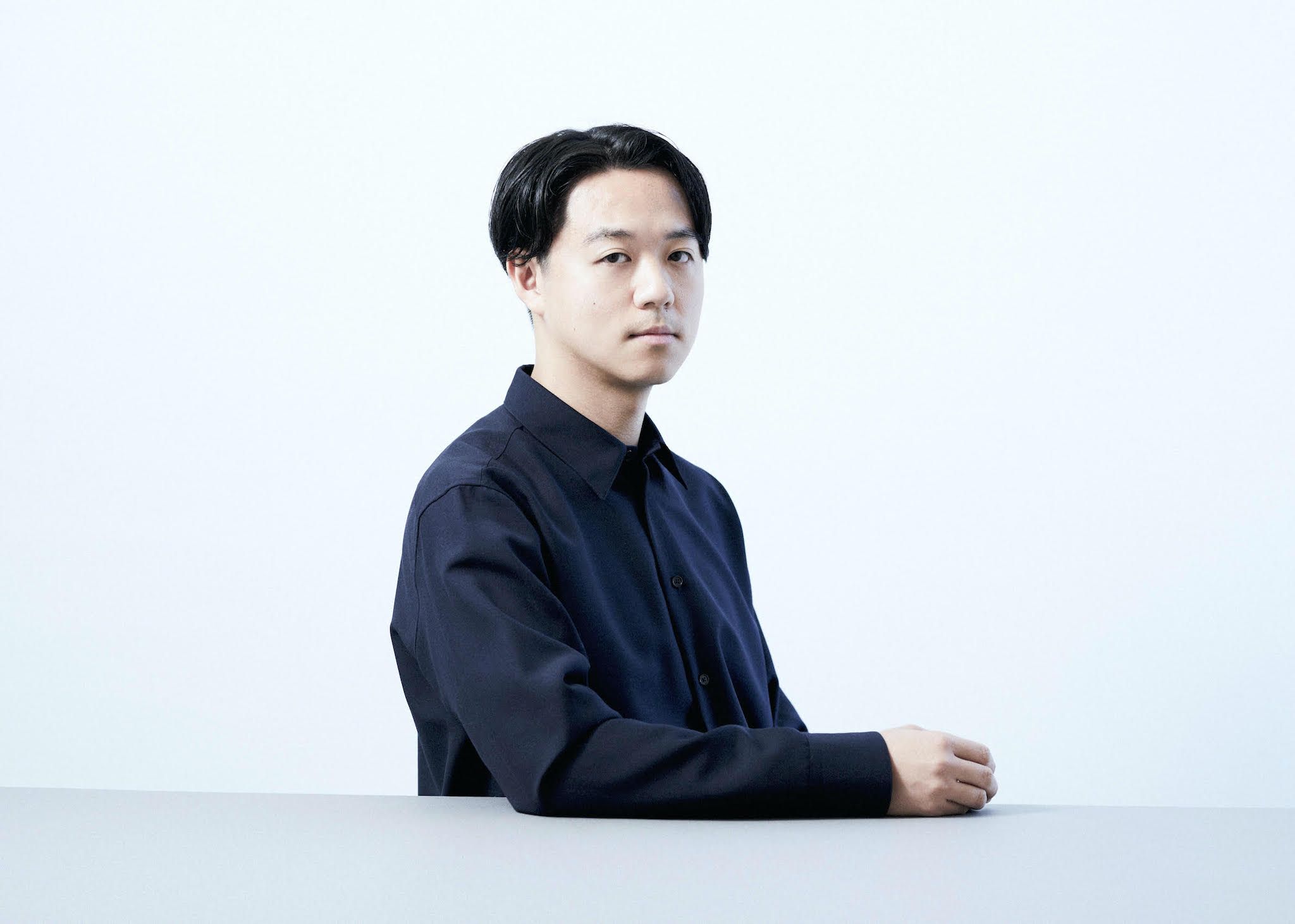
Your modern interpretations of the line between masculinity and femininity bleed through your designs and its versatility is blurring the preconceived ideas that most have about fashion. Everything is unisex. How do you continue to shatter these perceptions?
Obviously there are skeletal differences between men and women which we try to take into consideration when designing each piece. Since men who wear skirts and dresses are very few, we try to create those styles based on a feminine silhouette. However, when it comes to pants, outerwear and T-shirts, women can also wear the same styles designed for men. That is why we basically define our clothes as unisex. For us, color has nothing to do with gender and we try to create clothes that are friendly for all.
We live in a world where it is imperative that we adopt a more sustainable mindset to reduce the waste of materials. From what I can see, your designs consist primarily of 3D, computer-developed knitwear using certified, sustainable yarns. How else have you implemented sustainability into your designs?
We take the initiative to use recycled fibers as they are essential for sustainable development. We can't make clothes from raw materials, so we buy yarn from yarn manufacturers. The quality of recycled fiber has recently become as good as virgin polyester. However, the problem is that there are very little variations. If the use of recycled fiber becomes the top priority, it will be impossible to make clothes that fit the modern lifestyle. That's why we list the percentage of recycled fibers used on the product tag, some of which are 100% and some of which are 12%.
If all clothing manufacturers could use recycled fibers, we would be happy because the variety of yarns would increase. As our company grows, we hope to negotiate with yarn manufacturers to create more original recycled fibers.
You worked side by side with Issey Miyake for nearly a decade. What has been one of your biggest takeaways while working with him and how have you utilized everything that you learned there in your independent designs?
Since I joined Miyake Design Studio straight from University, it is not an exaggeration to say that I learned almost all of my design philosophy from him. If I had to pick one thing, it would be that confronting society is the most important aspect of making clothes, and that continuing to do so is what forms a culture. While I can only make clothes, my time at the studio taught me that clothes can create society and culture. I still keep that feeling and philosophy in mind when I design.
You use computer-program knitting, which sounds very technical but completely ultramodern at the same time. Could you explain this process?
We start with developing a partial sample that I believe will create the modern style I envision.
We carefully select and combine yarns then spend a long period of time making a number of choices in terms of structure, density, and a variety of options. For this process, we rely on our intuition and what flows naturally. Once we have a satisfactory partial sample we then make it clear the pilling test, friction test, and light fastness test. The next step is to create a design drawing on the iPad, describe the details, and finally ask the knit programmer to create it all.
After that, the products go through about three rounds of model fitting, revisions, washing and wear tests, and once they complete all those steps they are ready to be displayed at the exhibition. In order to ensure there is almost no waste or excess fabric scraps in the CFCL office we have no shelves for fabrics, no desks for cutting, and no plotters.
How have your designs helped you morph your vision into a living, breathing reality? In other words, when you first started the brand, what was Yusuke thinking?
Design is a means to make people's lives more comfortable and to help solve the problems that society has. The way I fulfill and assist in solving society’s problems is by working as a fashion designer and creating clothes. On the other hand, I will always want to make clothes just to excite and personally satisfy myself. To me, the best thing is being able to immerse myself in what I love and to help make society a better place.
Where do you hope to take your designs in the near future? What can you tell us about any future collection you have coming out?
I am always interested in using computer programmed knitting techniques to expand the existing image of knitwear which is commonly associated with things such as warmth, winter, etc. I also want to explore new possibilities of clothing such as creating things that aren’t usually done with woven fabrics. Knitwear can assemble three-dimensional garments directly from yarn and can easily showcase yarn’s characteristics and properties. With this versatility, yarn is going to become more and more essential in the future.





























© YUSUKE TAKAHASHI
Yusuke Takahashi
AUGUST 14, 2021 → WORDS RONALD KAHIHIKOLO
CFCL — Clothing For Contemporary Life — personifies designer Yusuke Takahashi’s aspiration to create sustainable unisex garments suitable for all occasions. Takahashi launched CFCL back in 2020, shortly after ending his seven-year-long tenure as director of Issey Miyake Men.
The core elements of the brand are built on sustainability and ethically made clothes that promote a minimal and modest look. With a timeless approach and ethos, CFCL implements cutting edge technology to create its astonishing garments. This season's garments consist primarily of 3D, computer-developed knitwear using certified, sustainable polyester yarns and state of the art technology. CFCL assesses knitwear as a progressive laboratory for innovative fashion-making that matches the needs of contemporary life with products that are sophisticated as they are easy to maintain.
CFCL's debut collection launched with 40 retailers worldwide: ISETAN, SKP, United Arrows, Galeries Lafayette, Tomorrowland as well as SSENSE.com and its own website www.CFCL.jp. This AW21 they will be launching with Selfridges.
What are the core elements of your brand? Why are these elements important for you to explore?
The core elements of the brand stem from our name CFCL which means to make “clothes for contemporary life.” Since the modern world is constantly evolving, we need to keep thinking and redefining what contemporary life is all about. At the moment, there are three core elements listed below that the brand stands for and if we find any of them missing from our garments, we will not allow the CFCL brand tag to be placed on it.
The core elements are:
Sophistication → We place importance on the integrity of our products which are suitable for an array of occasions in the city.
Consciousness → Not only do we use recycled fibers in all of our products, but we also place the importance on ensuring transparency by disclosing the percentage of certified recycled fibers used in mass production and the results of LCA calculations for all of our products (currently only some, but in the future all).
Comfort and Easy-care → With the exception of wool sweaters and lined coats, all products can be washed using a washing machine at home. We value clothing elements such as quick drying, wrinkle resistance, lightweight and stretchy material.
The centerfold of your designs revolve around easy-to-wear garments. How do you come up with your designs and how long does one design usually take?
The most distant future design I am currently working on is an item for the Autumn/Winter season of 2023. Often developing yarn and creating our structured garments made of knit material can be very time consuming. Once the partial swatches are completed, the final design will be completed after three rounds of model fitting (roughly four months).

Your modern interpretations of the line between masculinity and femininity bleed through your designs and its versatility is blurring the preconceived ideas that most have about fashion. Everything is unisex. How do you continue to shatter these perceptions?
Obviously there are skeletal differences between men and women which we try to take into consideration when designing each piece. Since men who wear skirts and dresses are very few, we try to create those styles based on a feminine silhouette. However, when it comes to pants, outerwear and T-shirts, women can also wear the same styles designed for men. That is why we basically define our clothes as unisex. For us, color has nothing to do with gender and we try to create clothes that are friendly for all.
We live in a world where it is imperative that we adopt a more sustainable mindset to reduce the waste of materials. From what I can see, your designs consist primarily of 3D, computer-developed knitwear using certified, sustainable yarns. How else have you implemented sustainability into your designs?
We take the initiative to use recycled fibers as they are essential for sustainable development. We can't make clothes from raw materials, so we buy yarn from yarn manufacturers. The quality of recycled fiber has recently become as good as virgin polyester. However, the problem is that there are very little variations. If the use of recycled fiber becomes the top priority, it will be impossible to make clothes that fit the modern lifestyle. That's why we list the percentage of recycled fibers used on the product tag, some of which are 100% and some of which are 12%.
If all clothing manufacturers could use recycled fibers, we would be happy because the variety of yarns would increase. As our company grows, we hope to negotiate with yarn manufacturers to create more original recycled fibers.
You worked side by side with Issey Miyake for nearly a decade. What has been one of your biggest takeaways while working with him and how have you utilized everything that you learned there in your independent designs?
Since I joined Miyake Design Studio straight from University, it is not an exaggeration to say that I learned almost all of my design philosophy from him. If I had to pick one thing, it would be that confronting society is the most important aspect of making clothes, and that continuing to do so is what forms a culture. While I can only make clothes, my time at the studio taught me that clothes can create society and culture. I still keep that feeling and philosophy in mind when I design.
You use computer-program knitting, which sounds very technical but completely ultramodern at the same time. Could you explain this process?
We start with developing a partial sample that I believe will create the modern style I envision.
We carefully select and combine yarns then spend a long period of time making a number of choices in terms of structure, density, and a variety of options. For this process, we rely on our intuition and what flows naturally. Once we have a satisfactory partial sample we then make it clear the pilling test, friction test, and light fastness test. The next step is to create a design drawing on the iPad, describe the details, and finally ask the knit programmer to create it all.
After that, the products go through about three rounds of model fitting, revisions, washing and wear tests, and once they complete all those steps they are ready to be displayed at the exhibition. In order to ensure there is almost no waste or excess fabric scraps in the CFCL office we have no shelves for fabrics, no desks for cutting, and no plotters.
How have your designs helped you morph your vision into a living, breathing reality? In other words, when you first started the brand, what was Yusuke thinking?
Design is a means to make people's lives more comfortable and to help solve the problems that society has. The way I fulfill and assist in solving society’s problems is by working as a fashion designer and creating clothes. On the other hand, I will always want to make clothes just to excite and personally satisfy myself. To me, the best thing is being able to immerse myself in what I love and to help make society a better place.
Where do you hope to take your designs in the near future? What can you tell us about any future collection you have coming out?
I am always interested in using computer programmed knitting techniques to expand the existing image of knitwear which is commonly associated with things such as warmth, winter, etc. I also want to explore new possibilities of clothing such as creating things that aren’t usually done with woven fabrics. Knitwear can assemble three-dimensional garments directly from yarn and can easily showcase yarn’s characteristics and properties. With this versatility, yarn is going to become more and more essential in the future.